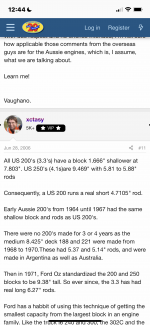I have an additional question about compression ratio. I have another engine that’s a 1978 ford 200 - 20 over standard bore- and a 1969 big log head- C9DE 6090 M. The head has been milled about 25 and the deck to piston height is zero. The combustion chamber is 60 CC. The dished pistons are 20 CC. looking to wind up with anywhere from 8.8 - 9.0..Can I mill enough off the head? 420 lift cam - 209 duration @50. 104 centerline..Not sure where I’m at right now with a Felpro gasket? I’m not a math expert- LOL any helpful responses will be appreciated.
You are using an out of date browser. It may not display this or other websites correctly.
You should upgrade or use an alternative browser.
You should upgrade or use an alternative browser.
All Small Six Compression
- Thread starter Spike56
- Start date
This relates to all small sixes
You have all the data to run the compression calculator for static compression. Adding the intake valve closing point and rod length you can also get dynamic compression. If you want to calculate dynamic, we can help you determine intake closing point. DON'T use ".005" duration + 15*" method suggested in the calculator.
 uempistons.com
uempistons.com
Compression Ratio Calculator | UEM Pistons
 uempistons.com
uempistons.com
Your calculated static CR is 7.29. The 20cc dished piston is killing your compression. To get a CR of 8.8, your head would have to have a combustion chamber of 43cc; not possible to mill that much off the head.I have an additional question about compression ratio. I have another engine that’s a 1978 ford 200 - 20 over standard bore- and a 1969 big log head- C9DE 6090 M. The head has been milled about 25 and the deck to piston height is zero. The combustion chamber is 60 CC. The dished pistons are 20 CC. looking to wind up with anywhere from 8.8 - 9.0..Can I mill enough off the head? 420 lift cam - 209 duration @50. 104 centerline..Not sure where I’m at right now with a Felpro gasket? I’m not a math expert- LOL any helpful responses will be appreciated.
The Compression Ratio Calculator that Frank posted will help you determine what changes to the engine parameters you would have to make to get the desired CR. Just throwing numbers into the Calculator, changing the pistons to 8cc dished would give you a 8.3 CR; changing to flat top pistons would give you a 9.14CR
I don't know the rod length of the small 6's, but someone on here does, and I'm sure it's posted somewhere.I haven’t calculated dynamic ever.
my static is about 10.2
What is stock rod by length and how is it measured?
How would you figure intake closing?
To calculate intake valve close point: Camshaft advertised duration (gross duration, not .050") divided by two. Add the Lobe Separation Angle. Subtract 180. This is the intake closing point after Bottom Dead Center on the compression stroke with a cam that is not advanced or retarded. Sense compression doesn't start until the valve is (nearly) closed, this calculation is critical to determine grade of fuel needed, etc. . Actual running compression is determined by the camshaft, the static compression is only a build foundation to match the cam selected. The more mild the cam, the higher the compression ratio and fuel grade required will be for a given Static Compression.
Example of finding IVCP: Cam specs say duration is 205*/260* intake duration, the LSA (Lobe Separation Angle) is 110*
260* divided by 2 = 130. 130+110(LSA)= 240. 240-180= 60 The intake valve on this cam closes @ 60* ABDC. This is with the cam straight-up. Most cams are ground with 4* advance built into the grind. The advance/retard is added/subtracted from this final closing point number. If the cam is advanced, subtract the *'s of advance from the total, if it's retarded, add the *'s of retard to the total.
From the example above: if this cam is advanced 4* the IVC point is 60-4=56* ABDC. If it is retarded 4* the IVCP is 60+4=64* ABDC Insert this final number in the last line of the calculator.
Ideally, the build plan begins with the camshaft chosen, and the target DCR known. Then work backward to determine the piston dish, piston compression height, and head volume. The UEM Calculator is the foundation for deciding what parts are going to produce a matched build- when starting with the camshaft, and the intake valve closing point.
Thank you
Thank youfor the info I kind of figured this was going to be the avenue I’d need to take. I suppose if I put flat top pistons in Il need to rebalance the entire assembly?Your calculated static CR is 7.29. The 20cc dished piston is killing your compression. To get a CR of 8.8, your head would have to have a combustion chamber of 43cc; not possible to mill that much off the head.
The Compression Ratio Calculator that Frank posted will help you determine what changes to the engine parameters you would have to make to get the desired CR. Just throwing numbers into the Calculator, changing the pistons to 8cc dished would give you a 8.3 CR; changing to flat top pistons would give you a 9.14CR
Thank you for the detailed informationI don't know the rod length of the small 6's, but someone on here does, and I'm sure it's posted somewhere.
To calculate intake valve close point: Camshaft advertised duration (gross duration, not .050") divided by two. Add the Lobe Separation Angle. Subtract 180. This is the intake closing point after Bottom Dead Center on the compression stroke with a cam that is not advanced or retarded. Sense compression doesn't start until the valve is (nearly) closed, this calculation is critical to determine grade of fuel needed, etc. . Actual running compression is determined by the camshaft, the static compression is only a build foundation to match the cam selected. The more mild the cam, the higher the compression ratio and fuel grade required will be for a given Static Compression.
Example of finding IVCP: Cam specs say duration is 205*/260* intake duration, the LSA (Lobe Separation Angle) is 110*
260* divided by 2 = 130. 130+110(LSA)= 240. 240-180= 60 The intake valve on this cam closes @ 60* ABDC. This is with the cam straight-up. Most cams are ground with 4* advance built into the grind. The advance/retard is added/subtracted from this final closing point number. If the cam is advanced, subtract the *'s of advance from the total, if it's retarded, add the *'s of retard to the total.
From the example above: if this cam is advanced 4* the IVC point is 60-4=56* ABDC. If it is retarded 4* the IVCP is 60+4=64* ABDC Insert this final number in the last line of the calculator.
Ideally, the build plan begins with the camshaft chosen, and the target DCR known. Then work backward to determine the piston dish, piston compression height, and head volume. The UEM Calculator is the foundation for deciding what parts are going to produce a matched build- when starting with the camshaft, and the intake valve closing point.
Thank you - performance wise would I be better off going with the 8 cc dish and milling alittle more off my head or leave the head at 60cc and going with the flat top?Your calculated static CR is 7.29. The 20cc dished piston is killing your compression. To get a CR of 8.8, your head would have to have a combustion chamber of 43cc; not possible to mill that much off the head.
The Compression Ratio Calculator that Frank posted will help you determine what changes to the engine parameters you would have to make to get the desired CR. Just throwing numbers into the Calculator, changing the pistons to 8cc dished would give you a 8.3 CR; changing to flat top pistons would give you a 9.14CR
That depends on you camshaft selection, as explained above.Thank you - performance wise would I be better off going with the 8 cc dish and milling alittle more off my head or leave the head at 60cc and going with the flat top?
4 1/2 thou makes a difference in compression numbers. This variable in rod length affects the "deck clearance" line on the calculator. For a real-world example, adding this difference into the calculation for my 240 build changed the dynamic compression .15 points. Enough to put it over the threshold for regular gas, since it's already built right at that number.4.7105?? Not that what…4 1/2 thousandths will make that much difference in compression numbers
The tighter the parts get in the cylinder (milled block/head, small dish or flat-top pistons) the more the deck clearance # affects CR.
(The 4 1/2 thou rod length difference will not change the calculator much on the "rod length" line, but since it changes the piston compression height, the deck clearance line is changed by that much.)
An accurate "deck clearance" # is critical to an accurate CR value, determined by the piston pin height, or "compression height".
Last edited:
No inline engines are balanced without bob weights. Unlike a V configuration where the mass of the reciprocating parts matter, an inline engine is balanced via the counter weights and throws on the crank. Other than that con rods and pistons should be balanced in the same manner but selecting the lightest and making the rest match.Thank you
Thank youfor the info I kind of figured this was going to be the avenue I’d need to take. I suppose if I put flat top pistons in Il need to rebalance the entire assembly?
Just by design the 8cc pistons will be better due to larger quench area, that in itself will help with detonation if you have between .030 and .050 quench. I avoid the larger dish pistons as they have a very small squish band.Thank you - performance wise would I be better off going with the 8 cc dish and milling alittle more off my head or leave the head at 60cc and going with the flat top?
Most engine I build for the street end up being about 9.5:1 static, then I calculate my intake closing and exhaust duration from there to put the dynamic ratio where I want it. You can actually run whatever static ratio you like as long as you have enough cam to drop the dynamic compression ratio to a safe zone ro reduce the ignition timing.
I have built 11.5:1 351 Windsor's with GT40P heads on pump gas 32 degrees of timing, .035 quench and enough cam and valve overlap to not make it ping on premium. I would outrun similar engines built with much less static and what most of the internet calls 'Safe for iron head engines'.
Similar threads
- Replies
- 9
- Views
- 3K
- Replies
- 27
- Views
- 9K
- Replies
- 12
- Views
- 4K

